Midwest Meteorites
Meteorite Coins
'Elagabalus'
Varius Avitus Bassianus
(AD 204 - AD 222)
COIN 1
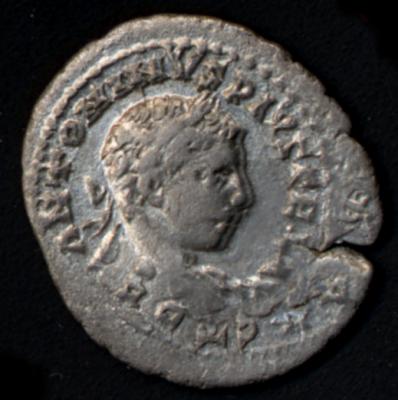
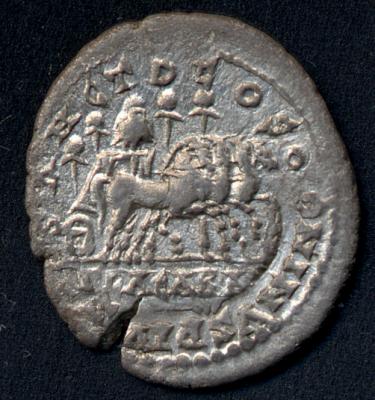
COIN 17
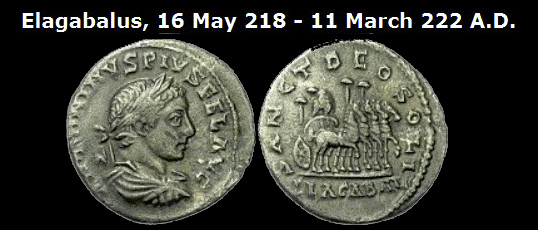
ELAGABALUS, Augustus 218-222 A.D.
Elagabalus would put the sacred stone into a cart led by a team of matched
white horses, with the Emperor himself leading the procession by walking backwards ahead of the cart.
The processions were immortalized through the image of the Stone of Emesa and
the horse-drawn cart being stamped into the reverse of Roman coins.
The face of this denarius shows a draped and cuirased bust of
Elagabalus. The reverse shows a quadriga (a cart pulled by four horses)
bearing the Stone of Emesa. This coin was minted in Antioch.
ELAGABALUS, Augustus 218-222 A.D. Varius Avitus Bassianus was a teenager who attained the throne
through the efforts of two powerful Syrian women: his grandmother Julia Maesa, and mother Julia Soaemias. Maesa used her wealth
to enlist legionaries in an uprising against the unpopular Emperor, Macrinus, and the Senate acquiesced in their acclamation of the
young Bassianus. Elagabalus eventually alienated the establishment with his religious practices and sexual habits, and the
Praetorian Guard killed him and Soaemias.
JULIA SOAEMIAS, Augusta 218-222 A.D. Daughter of Julia Maesa, and mother of Elagabalus, Julia
Soaemias was the wife of Varius Marcellus. In her effort to support Elagabalus as priest of the Unconquerable Sun (Sol Invictus) god,
Soaemias tied herself directly to his fate. As he rose to power, she did also. And when the Praetorian Guard murdered him for his
excesses, she joined him in death, and in having her body thrown into the Tiber River. Coins bearing her image are all scarce.
COIN 2
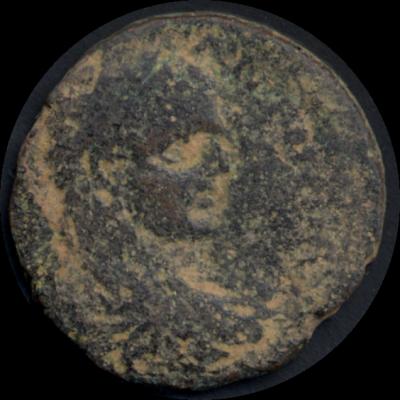
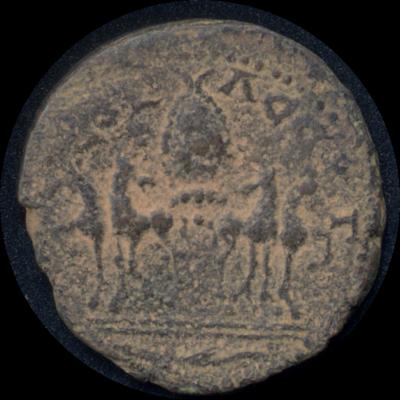
The face of this coin shows a laureate and draped bust of Elagabalus.
The reverse shows the Stone of Emesa in a facing quadriga. This coin was minted in Jerusalem.
ELAGABALUS, Augustus 218-222 A.D.
COIN 3
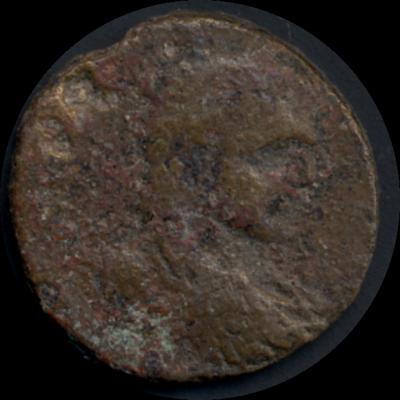
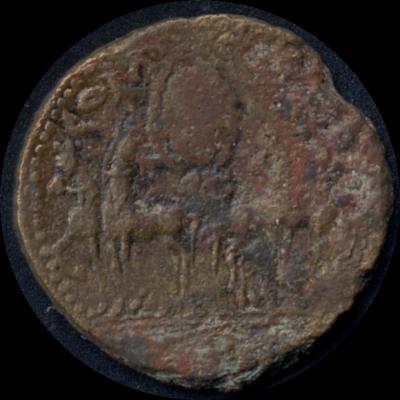
The face of this coin shows a draped and cuirassed bust of Caracalla,
predecessor of Elagabalus. The reverse shows the Stone of Emesa
ornamented with an eagle and flanked by two parasols, on a chariot
drawn by four horses, tendril in exergue. This coin was minted in
Jerusalem.
COIN 4
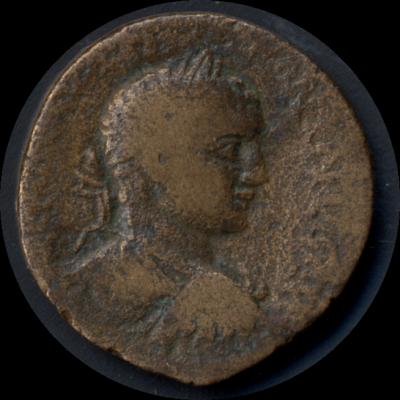
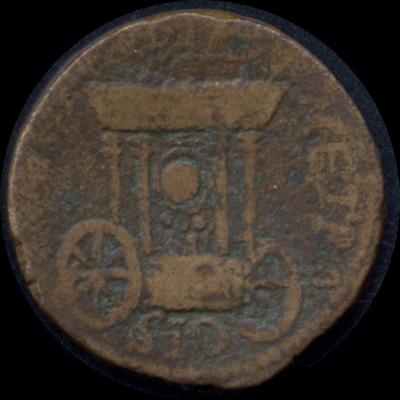
The face of this coin shows a laureate and draped bust of Elagabalus.
The reverse shows the Cart of Astarte bearing either the Stone of
Emesa or the stone of Sidon. Small figures appear on either side. This
coin was minted in Sidon.
COIN 5
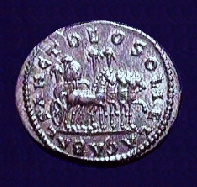
ELAGABALUS, Augustus 218-222 A.D.
COIN 6
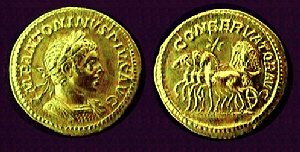
ELAGABALUS, Augustus 218-222 A.D.
COIN 7
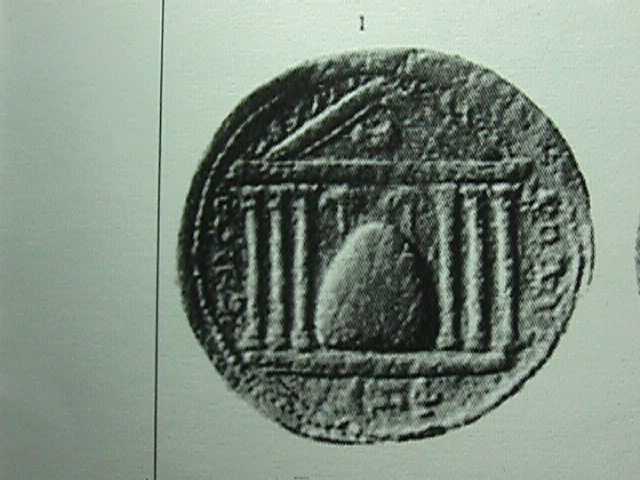
COIN 8

COIN 9
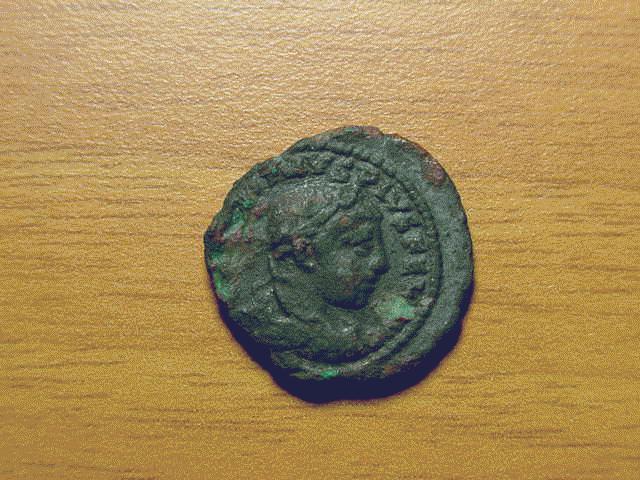
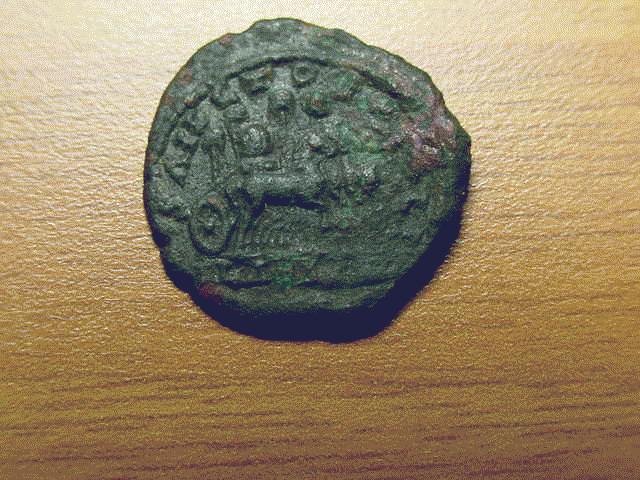
ELAGABALUS, Augustus 218-222 A.D.
Elagabalus, base denarius, (g) Base metal imitation of an Eastern Mint, from the Balkan frontier, [IMP ANTO]NINVS PIVS FEL Laureate, draped and cuirassed bust right,
seen from behind. / SANCT DE[O SOLI] ELAGABAL Stone of Emesa in chariot pulled by four horses. RIC 144. Toned VF, some corrosion and encrustation, partial
legends.
One of the most historical of all Roman coins, this reverse type commemorates the journey undertaken by Elagabalus and his retinue from Syria to Rome over the winter of
218 to 219. The center piece of the procession was the famed Stone of Emesa, a meteorite worshipped by the Sun Cult of which the new emperor was the chief priest.
COIN 10
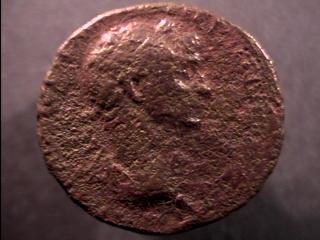
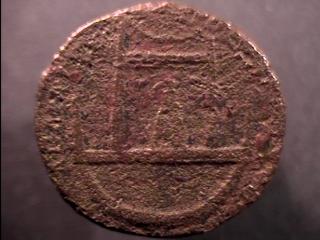
Coin 11
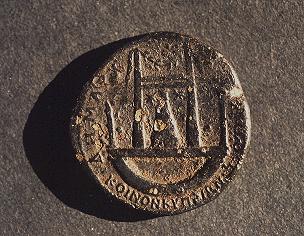
Trajan, Cyprus, stone F
Trajan, Æ as, (11.08g) Paphos, Cyprus, Latin legend. Laureate, draped and
cuirassed bust right. / Temple of Aphrodite at Paphos containing a conical terrestrial stone incourtyard.
F, cast flan. The obverse die appears to be a Roman Imperial.
The stone that was at the center of this temple was found by archeologists
a short distance from the temple and has been confirmed not to be a meteorite.
The Temple of Aphrodite at Paphos did not contain a meteorite, it was a terrestrial rock
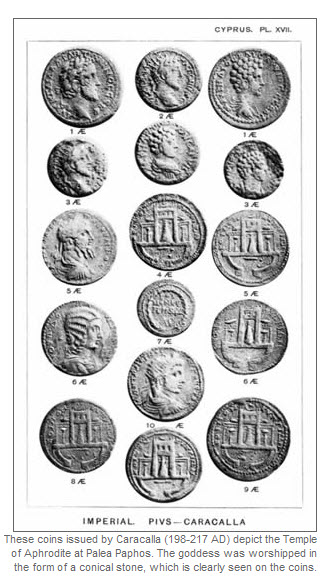
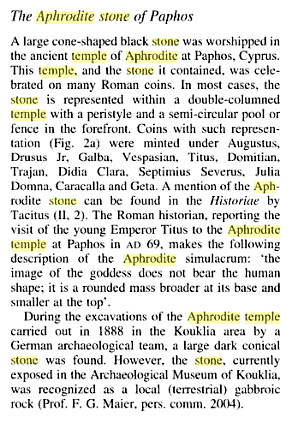
Coin 12 - The Temple of Aphrodite at Paphos
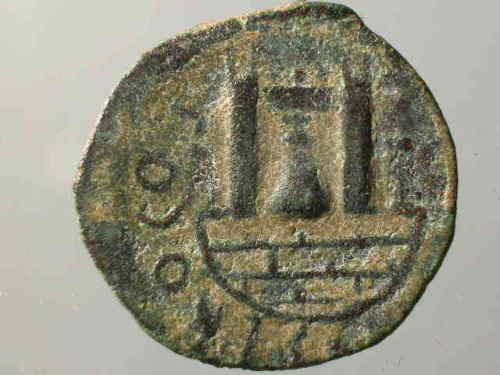
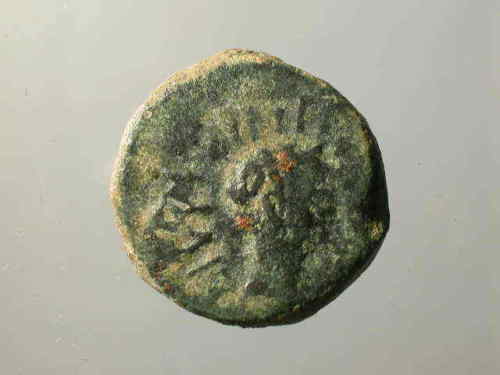
Coin 13 - The Temple of Aphrodite at Paphos
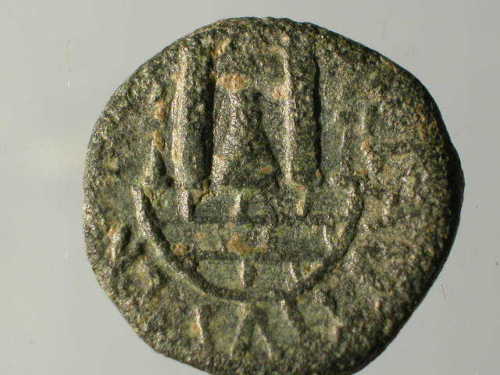
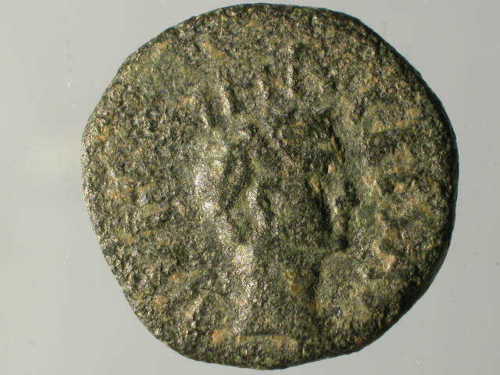
Coin 14 - The Temple of Aphrodite at Paphos
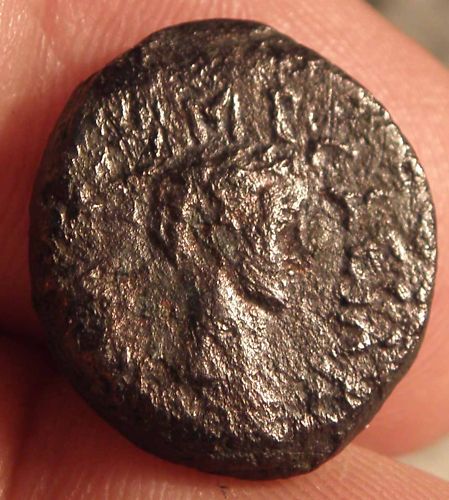
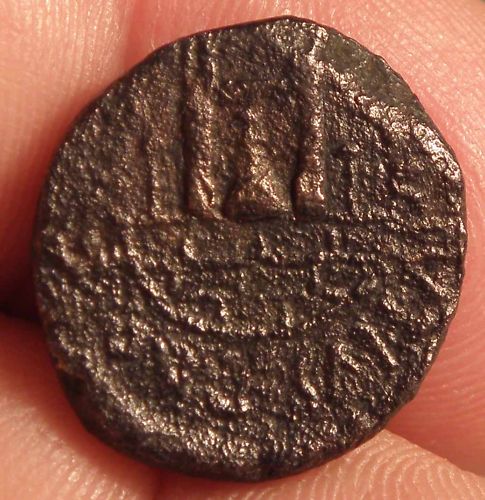
AUGUSTUS 27 B.C. - 14 A.D.
CYPRUS MINT
AE 16mm
Obv.: Head of Augustus to right.
Rev.: Temple of Aphrodite at Paphos.
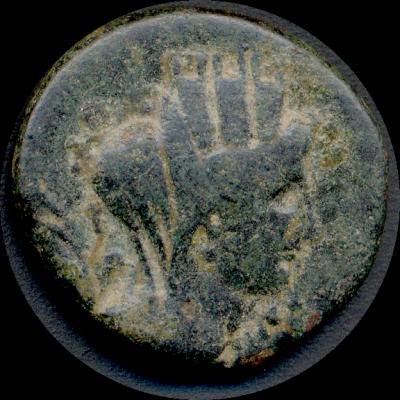
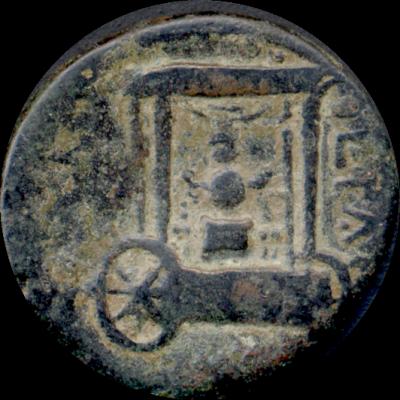 Trajan,Cyprus
Trajan,Cyprus
The face of this civic issue coin displays a turretted and draped bust
of Tyche, the goddess of good fortune (Roman Fortuna). The reverse
shows the wheeled cart of Astarte bearing a sacred stone, possibly the
Stone of Emesa. However, Sidon possessed another sacred stone which
was displayed in the cart of Astarte, so this may be that stone instead.
This coin was minted in Sidon during the reign of Trajan (A.D. 98-117).
Coin 16
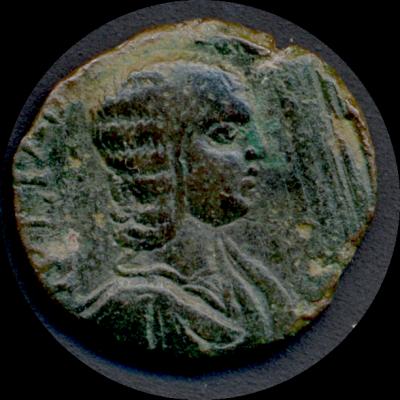
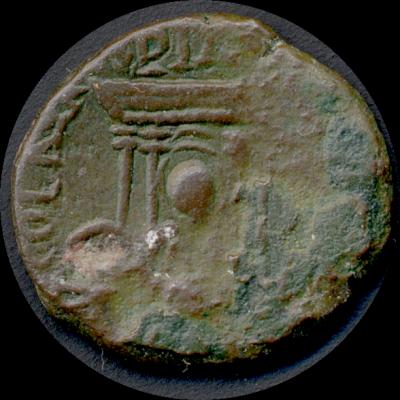
The face of this coin displays a draped bust of Julia Maesa, the
grandmother of Elagabalus. The reverse shows the cart of Astarte
bearing the either the Stone of Emesa or the sacred stone of Sidon.
This coin was minted in Sidon.
Elagabalus
Elagabalus
Emperor A.D 218 - 222
Elagabalus was born Varius Avitus Bassianus in AD 203 or 204 at Emesa in Syria.
He was the son of the Syrian Sextus Varius Marcellus, who had become senator during the reign of Caracalla and Julia Soaemias.
It was though his mother that Elagabalus should enjoy astounding connections. For his maternal grandmother was Julia Maesa, widow to the consul Julius Avitus. She was the younger sister of Julia Domna, widow of Septimius Severus and mother of Geta and Caracalla.
Elagabalus held the hereditary rank of high priest to the Syrian sun god El-Gabal (or Baal).
The ascension to the throne by Elgabalus was entirely due to his grandmother's will to see the downfall of Macrinus. Julia Maesa clearly held emperor Macrinus responsible for her sister's death and now sought revenge.
With Macrinus losing support with his peace deeply unpopular settlement with the Parthians, the time seemed for an attempt of overthrowing him.
A rumour now was spread by Julia Soaemias herself, that Elagabalus had actually been fathered by Caracalla. If the memory of Caracalla was much cherished in the army, then support for his 'son' Elagabalus was now easily found.
All along a mysterious figure called Gannys seems to have masterminded the plot against emperor Macrinus. He appears to have been either a eunuch servant of Julia Maesa, or in fact the lover of Julia Soaemias.
Then, on the night of 15 May AD 218, the fateful moment arrived for Julia Maesa to let her plot unfold. Elagabalus, who was only fourteen years old, was secretly taken to the camp of the Legio III 'Gallica' at Raphaneae and at the dawn of 16 May AD 218 he was presented to the troops by their commander Publius Valerius Comazon.
Had the troops been bribed by a substantial sum paid for by the wealthy Julia Maesa, Elagabalus was hailed emperor and assumed the name Marcus Aurelius Antoninus. Nonetheless, he should become known as 'Elagabalus', the Romanized name of his god.
Remarkably, it was now Gannys who assumed command of the army which marched against Macrinus. As he advanced, his forces gathered strength, with more and more units of Macrinus' changing sides. Finally, on 8 June AD 218 the two forces met outside Antioch. Gannys was victorious and Macrinus was executed shortly after and Elagabalus was thereafter recognized as ruler throughout the empire.
The senate responded by acknowledging him as emperor, confirming him the son of Caracalla, as well as deifying his 'father' Caracalla.
What is also noteworthy is that Elagabalus was not the only person to be elevated by the senate.
His all-important grandmother Julia Maesa and his mother Julia Soaemias were each proclaimed Augusta, - empress. There was no doubt with whom real power resided. It was definitely through these two women that now the empire should be governed.
Gannys now fell by the wayside. If at first there appeared to have been the intention of making him Caesar marrying to Julia Soaemias, then he was executed at Nicomedia.
Already before the imperial entourage reached Rome things began to sour. The very unit which had first bestowed imperial honours on Elagabalus, revolted and instead proclaimed its new commander Verus emperor (AD 218). However, the revolt was quickly suppressed.
The arrival of the new emperor and his two empresses at Rome in the autumn of AD 219 left the entire capital aghast. Among his imperial entourage Elagabalus had brought with him many low-born Syrians, who were now granted positions in high office. Foremost among these Syrians was the very commander who had proclaimed Elagabalus emperor at Raphaneae, Publius Valerius Comazon. He was given the post of Praetorian prefect (and later city prefect of Rome) and became the most influential figure in government, aside from Julia Maesa.
But the greatest shock by far to the Romans came when they learnt that Elagabalus had in fact brought the 'Black Stone' with him from Emesa. This stone was in fact the most holy object of the cult of the Syrian god El-Gabal and had always resided in its temple at Emesa. With it coming to Rome it was made obvious to everyone that the new emperor intended to continue his duties as a priest of El-Gabal while residing at Rome. This was unimaginable.
Though in spite of such public outrage it did happen. A great temple was built on the Palatine hill, the so-called Elagaballium - better known as the 'Temple of Elagabalus', to hold the holy stone.
Having got off to such a bad start, the new emperor desperately needed to somehow improve his standing in the eyes of his Roman subjects. And so, already in AD 219 his grandmother organized a marriage between him and Julia Cornelia Paula, a lady of noble birth.
Any attempts to enhance Elagabalus' standing with this marriage were however soon undone, by the ardour with which he undertook the worship of his god El-Gabal. Cattle and sheep were sacrificed in great numbers every day at dawn. High ranking Romans, even senators, had to attend these rites.
There are reports of severed human genitalia and small boys being sacrificed to the sun god. Although the truthfulness of these claims is very doubtful.
In AD 220 the emperor's plans became known, that he intended to make his god El-Gabal the first and foremost god (and master of all other gods!) of the Roman state cult. As if this was not enough, it was also decided that El-Gabal was to marry. In order to achieve symbolical step, Elagabalus had the ancient statue of Minerva from the Temple of Vesta taken to the Elagaballium where it was to be married to the Black Stone. As part of this marriage of gods, Elagabalus also divorced his wife and married one of the Vestal Virgins, Julia Aquilia Severa (AD 220).
Had in earlier days sexual relations with a Vestal Virgins meant the immediate death penalty for both her and her lover, then this marriage of the emperor only further enraged public opinion.
Although the marriage between Elagabalus and Aquilia Severa went ahead, the emperor's religious aspirations for El-Gabal had to be abandoned, for fear of the public's reaction.
Instead the god El-Gabal, by now known to the Romans as Elagabalus - the same name used for their emperor, - was 'married' to the less controversial moon goddess Urania.
If he had married the Vestal Severa in AD 220, then he already divorced her again in AD 221. In July of that year he married Annia Faustina, who had among her ancestors no lesser than emperor Marcus Aurelius. More alarmingly though her husband had only been executed on Elagabalus' orders a short while before the marriage. This marriage although was only to last a very brief time, before Elagabalus abandoned it and instead declared he had never truly divorced Aquilia Severa and instead lived with her again.
But this should apparently not be the end of Elagabalus' marital adventures. According to one account he had no less than five wives during his brief reign.
The Ellagabalium was not sufficient for the glory of El-Gabal, the emperor appears to have decided at some point. And so a huge temple of the sun was built outside Rome, where to the black stone was taken each year at midsummer in a triumphal procession. The emperor himself running backwards ahead of the chariot, whilst holding the reigns of the six white horses which pulled it, thereby fulfilling his duty never to turn his back on his god.
Though Elagabalus should not only achieve notoriety with his religious fanaticism. He should also shock Roman society with his sexual practices.
Were the Romans quite used to learning of their emperors - among them even the mighty Trajan -having a liking for young boys, then they had evidently never had an emperor such as Elagabalus.
It appears most likely that Elagabalus was homosexual, for his interests lay clearly with men, and he seemed to have shown little desire for any of his wives. Further to this, Elagabalus seemed to bear the desire in him to be a woman.
He had the hairs plucked from his body in order to appear more female, and delighted in appearing in public wearing make-up.
And he is said to have promised his physicians large sums of money if they would find away to operate on him and turn him into a woman.
More so, at court a blond Carian slave named Hierocles acted as the emperor's 'husband'.
Accounts also point to Elagabalus enjoying to pretend being a prostitute, offering himself naked to passers by in the palace, or even prostituting himself in the taverns and brothels of Rome. Meanwhile he would often arrange it to be caught by Hierocles, who would then be expected to punish him for his behaviour with a severe beating.
It was perhaps little surprising that within the ranks of the army Elagabalus did not carry undivided support. Had the revolt of the III 'Gallica' in Syria been an early warning, then since there had been revolts by the fourth legion, parts of the fleet, and a certain Seleucius.
Such sexual antics, combined with his religious activities, made Elagabalus an ever more unbearable emperor for the Roman state. Julia Maesa alas decided that the young emperor and his mother Julia Soaemias, who increasingly encouraged his religious fervour, were truly out of control and would have to go. And so she turned to her younger daughter Julia Avita Mamaea, who had a thirteen year old son, Alexianus.
The two women managed to persuade Elagabalus to adopt Alexianus as Caesar and heir. They explained to him that this would allow him to spend more time with his religious duties, while Alexianus would take care of other ceremonial obligations. And so Alexianus was adopted as Caesar under the name of Alexander Severus.
Soon afterwards however, in late AD 221, though Elagabalus changed his mind and tried to have Alexander assassinated. Perhaps by then he had realized what his grandmother intended.
In any case, Julia Maesa and Julia Mamaea managed to foil these attempts. Then they bribed the praetorian guards to rid the empire of its Syrian prince.
On 11 March AD 222, when visiting the praetorian camp, the emperor and his mother Soaemias were set upon by the troops and killed.
They were beheaded and their bodies were then dragged through the streets of Rome and, alas, thrown into the Tiber. A large number of Elagabalus' henchmen subsequently also met with a violent death.
The black stone of god El-Gabal was sent back to its true home at the city of Emesa. Roman Coins
Back to Main page





























